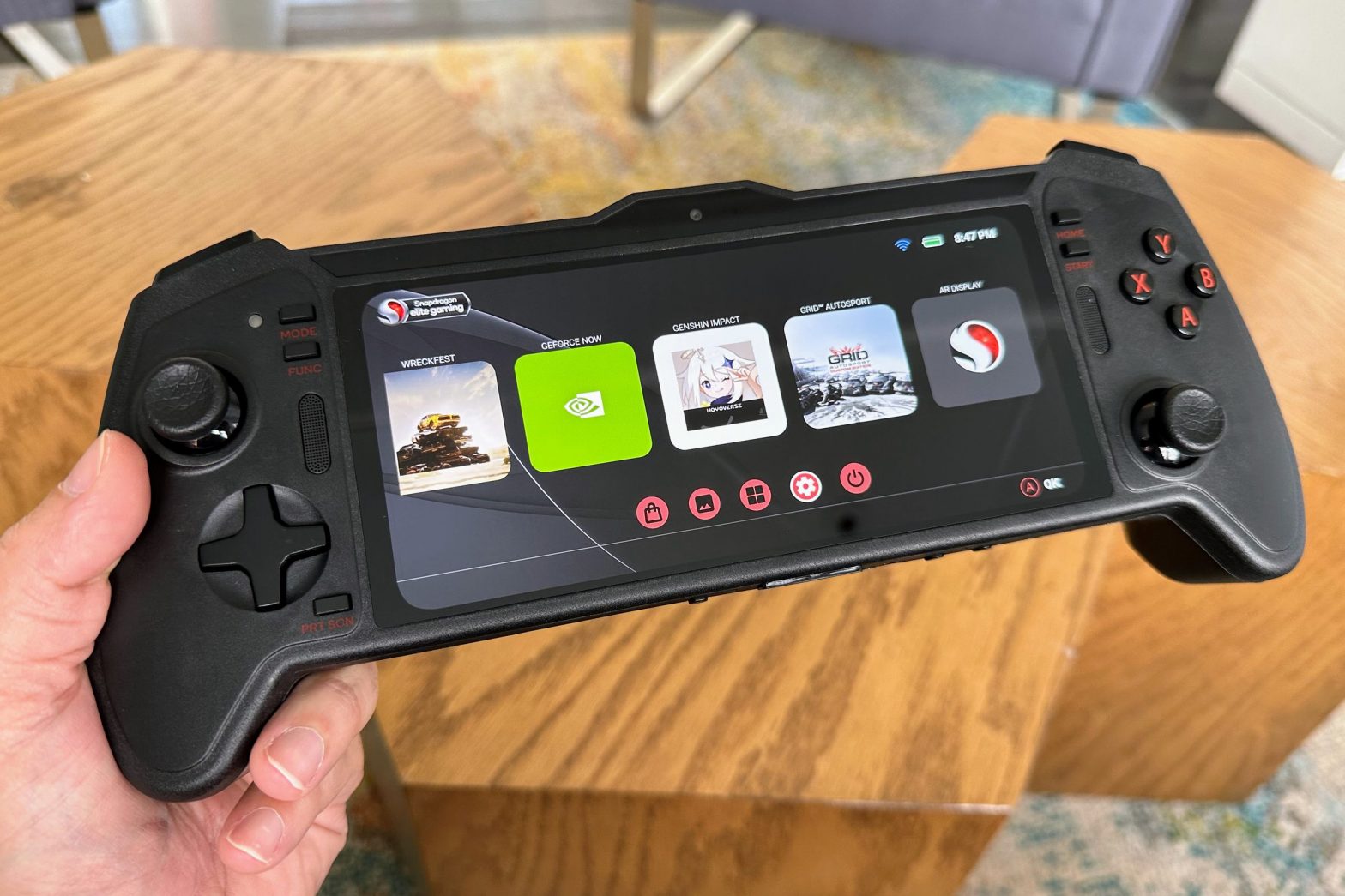/
It might be a stepping stone to portable Xbox, PlayStation, and PC games.
Share this story
:format(webp)/cdn.vox-cdn.com/uploads/chorus_asset/file/24867220/IMG_0249.jpg)
Two years ago, we told you how Qualcomm was eying the Nintendo Switch and Steam Deck, building a reference design that eventually morphed into the Razer Edge. And while Razer’s handheld was eventually hamstrung by truly ridiculous pricing, Qualcomm is now building three new chips to replace the previous one.
Today, the company’s announcing the “Snapdragon G Series handheld gaming portfolio” with three distinct tiers: a Snapdragon G1 for game-streaming handhelds with over 10 hours of battery life on Wi-Fi, a Snapdragon G2 for “full-featured mobile and cloud gaming” with 5G, and the Snapdragon G3x Gen 2 to start chasing PC gaming handhelds on performance.
:format(webp)/cdn.vox-cdn.com/uploads/chorus_asset/file/24867793/Snapdragon_G_Series_with_Specs.jpg)
Qualcomm says the G3x Gen 2 isn’t a glorified phone chip — it’s got twice the GPU performance of the Razer Edge’s first-gen chip thanks to a brand-new Adreno A32 GPU, plus over 30 percent faster CPU performance from its eight-core Qualcomm Kryo CPU. The chip’s peak performance is between 15 and 18 watts, far closer to the Steam Deck’s AMD Aerith system-on-chip than we’ve seen before, and Qualcomm claims it can sustain performance run after run after run.
Qualcomm’s chip may not quite have the performance of a Steam Deck yet, mind you — Qualcomm gaming director Mithun Chandrasekhar hedges when I ask. “I can theoretically crank the performance to 2GHz and beat the living shit out of other handheld devices, but then you’d get 30 minutes of battery life,” he says.
:format(webp)/cdn.vox-cdn.com/uploads/chorus_asset/file/24867461/IMG_0253.jpg)
Some firms are already intrigued: Ayaneo, a company that specializes in boutique gaming portables, will be among the companies to build a handheld gaming device around the new processors.
And crucially, Qualcomm is already looking beyond Android — beyond even Windows — to hedge its gaming bets.
“We’ve started working on stuff in-house that is not Android,” says Chandrasekhar, initially declining to elaborate. But when I press, he suggests it’s not necessarily Windows either. “We don’t think that ecosystem is quite ready yet and we don’t just want to throw a laptop shrunken down over the fence.”
So, I ask… is Qualcomm testing its chips with compatibility layers that let people play Windows games on other operating systems such as Valve’s Proton and Apple’s Game Porting Toolkit? Yes. And the G3x Gen 2 supports PCIe Gen 4 solid-state drives like a PC, not just UFS 4.0, he says.
:format(webp)/cdn.vox-cdn.com/uploads/chorus_asset/file/24867754/IMG_0251.jpg)
Even if this generation of Qualcomm chips doesn’t prove ready for PC games, console makers might also be interested. Microsoft promoted both the Razer Edge and Asus ROG Ally to give Xbox Game Pass a larger foothold, and Xbox Game Pass has a prominent position next to Nvidia GeForce Now on the demo machine I tried.
When I spot a PlayStation Remote Play logo in Qualcomm’s slide deck, Chandrasekhar admits the company is working with Sony, too, to figure out ways to make its games a normal part of the handheld ecosystem — maybe without requiring a Sony DualShock controller. It makes me wonder if Sony’s upcoming PlayStation Q handheld might be a Qualcomm partnership, too.
:format(webp)/cdn.vox-cdn.com/uploads/chorus_asset/file/24867861/Snapdragon_G3x_Gen_2_Reference_Design_with_Specs.jpg)
I hope there’s something exciting like the above possibilities coming down the pike — because by itself, today’s Qualcomm Snapdragon G3x Gen 2 Handheld gaming reference design is not a particularly compelling demo.
The main problem is it runs Android, where precious few games even try to take advantage of higher-end chips — and where some of the most popular, like PUBG Mobile, don’t support gamepads, last I checked. Reps try to show me a graphically unimpressive racing game and plug in a set of wired augmented reality glasses that don’t improve it one bit. (A native Android port of Wreckfest looks a bit better and could actually be confused for a PC game.) The 6.8-inch 144Hz OLED screen looks fine, but we can’t find any native games to push it, nor am I able to experience the included Wi-Fi 7’s theoretically incredible download speeds. I try Fortnite via Nvidia’s GeForce Now streaming service, but it doesn’t prove anything about what the new hardware is capable of.
But Qualcomm has been known to eventually channel a string of uncompelling demos into major wins down the road: we covered the company’s VR headset reference designs year after year after year after year until Meta finally plugged them into the relatively successful Oculus / Meta Quest headsets.
When I ask Chandrasekhar if the size of the market he’s looking at is similar to Quest (around 20 million units), he doesn’t answer directly. He says Qualcomm sees mobile as the only category of gaming with nonstop growth, and yet, gaming phones don’t seem to be catching on. “We’re seeing demand for gaming phones dropping precipitously,” he says.
At the same time, Qualcomm sees that game developers are starting to put “higher complexity games” on mobile — a porting process that’s made easier by middleware like Unreal Engine and Unity. For those titles, he believes sophisticated end users will want something more potent and purpose-built than the standard phone in their pocket, particularly if it doesn’t cost them too much.
“I want to hit $200 or sub-$200 for the G1,” says Chandrasekhar. That’s without Verizon subsidies. He teases that subsidies could bring the price all the way down to free.
